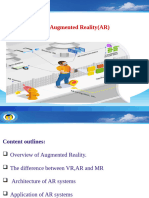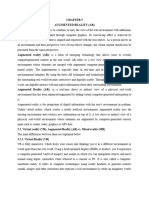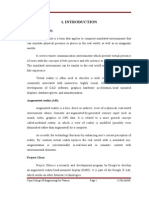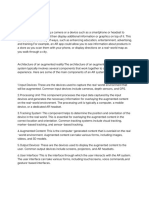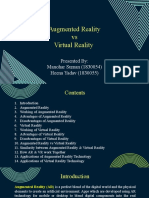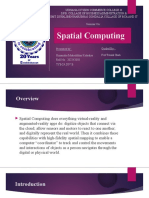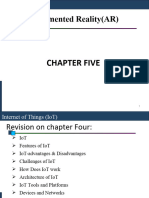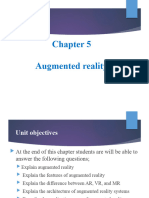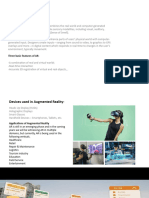Seminar 1
Seminar 1
Uploaded by
Anna Madel YopyopCopyright:
Available Formats
Seminar 1
Seminar 1
Uploaded by
Anna Madel YopyopOriginal Title
Copyright
Available Formats
Share this document
Did you find this document useful?
Is this content inappropriate?
Copyright:
Available Formats
Seminar 1
Seminar 1
Uploaded by
Anna Madel YopyopCopyright:
Available Formats
Anna Madel F Yopyop
BIT CPT 3
Please answer the following questions.
Define augmented reality (AR) and provide examples of how it differs from virtual reality.
Augmented Reality (AR) and Virtual Reality (VR) are both immersive technologies that
alter the perception of reality, but they differ in their approaches and the user experience
they provide. AR supplements the real world with digital information, while VR creates a
completely virtual environment, isolating users from their physical surroundings.
Augmented Reality overlays digital information or virtual elements onto the real-world
environment. AR systems typically use devices like smartphones, tablets, smart glasses, or
headsets to blend the virtual and real worlds seamlessly.
(e.g Pokémon GO, AR navigation apps, Augmented medical reality)
Virtual Reality, on the other hand, immerses users entirely in a computer-generated
environment, isolating them from the physical world. VR typically requires specialized
hardware.
Explain the concept of blending virtual and real-world elements in augmented reality
applications.
The basis of an augmented reality (AR) application is the idea of combining virtual and
physical elements. The goal of augmented reality (AR) is to smoothly combine computer-
generated content with the user's view of the outside world. Real-time overlaying of digital
content—such as pictures, movies, 3D models, or text—onto the physical world is how this
integration is accomplished. By including pertinent and meaningful virtual items inside
their context, the aim is to improve the user's perception and interaction with the
environment.
Provide examples of how augmented reality is used in education and training.
Engaging Textbooks
With AR, classic textbooks may become dynamic educational tools. Students may access extra
multimedia information, including films, 3D models, and interactive quizzes, by scanning
particular pages with a mobile device. This creates a more dynamic and interesting learning
environment.
Training for Vocational Skills:
AR is used in scenarios for occupational training, including manufacturing or maintenance. By
superimposing visual signals and step-by-step instructions on machinery or equipment, workers
may increase productivity and facilitate training.
Predict possible future trends in augmented reality technology.
augmented reality (AR) technology has quickly developed into a game-changing tool with far-
reaching effects. Future predictions point to a number of developments that will likely reshape
the AR technology environment and transform our interactions with both the digital and real
worlds. The future of AR hardware holds the promise of user-friendly and seamlessly
integrated devices. Anticipate the development of sleek, lightweight AR glasses or even
smart contact lenses, providing users with a more comfortable and immersive AR
experience. As hardware becomes less obtrusive, the barriers to widespread adoption are
likely to diminish, paving the way for AR to become an integral part of daily life.
Evaluate the advantages and disadvantages of using different types of devices for
augmented reality experiences.
Tablets and Smartphones:
Advantages
Widespread Accessibility: A large audience may readily access augmented reality experiences
due to the fact that almost everyone possesses a smartphone or tablet.
Cost-effective: As smartphones and tablets are often less expensive than dedicated AR
equipment, they can be widely adopted.
Portability: These gadgets are adaptable for a range of augmented reality applications since
they may be utilized anywhere and are portable.
Negative aspects:
Limited Immersion: Compared to more specialized AR devices, smartphones and tablets have a
smaller field of vision, which limits the immersive experience.
Dependency on Camera Quality: The quality of the device's camera, which varies among models,
is a major factor in augmented reality experiences.
You might also like
- Unit 5 Et (1ST Yr)Document13 pagesUnit 5 Et (1ST Yr)Vimal ChaudharyNo ratings yet
- The Self in PsychotherapyDocument26 pagesThe Self in PsychotherapyccvmdNo ratings yet
- Augmented Reality ResearchDocument12 pagesAugmented Reality ResearchmopefNo ratings yet
- What is VRDocument5 pagesWhat is VRcentnd1v1No ratings yet
- 3Document20 pages3arshi8995No ratings yet
- Augmented Reality AND Virtual RealityDocument13 pagesAugmented Reality AND Virtual RealityGoutham AS100% (3)
- Chapter 5 AR - NewDocument41 pagesChapter 5 AR - Newgirmayhaile384No ratings yet
- Virtual, Augmented and Mixed RealityDocument27 pagesVirtual, Augmented and Mixed Realitybene33% (3)
- Augmented and Virtual RealityDocument3 pagesAugmented and Virtual RealityAndres, JaysonNo ratings yet
- Chapter Five Augmented Reality (AR) : Emerging TechnologiesDocument10 pagesChapter Five Augmented Reality (AR) : Emerging TechnologiesAbdataa waaqaaNo ratings yet
- Introduction ArDocument3 pagesIntroduction ArnabeelNo ratings yet
- AR and VRDocument10 pagesAR and VRmosesNo ratings yet
- AR _ VRDocument4 pagesAR _ VRsudhansu biswalNo ratings yet
- DocumentationDocument24 pagesDocumentationa_34074092967% (3)
- Chapter FiveDocument18 pagesChapter FiveTade GaromaNo ratings yet
- Realizing The Potential of AR and VR by Tanya ShreeDocument12 pagesRealizing The Potential of AR and VR by Tanya ShreeTanya ShreeNo ratings yet
- Introduction To Emerging Technology: Augmented Reality (AR)Document12 pagesIntroduction To Emerging Technology: Augmented Reality (AR)Alemayehu Negash100% (2)
- Augmented RealityDocument16 pagesAugmented Realitysilvestar100% (1)
- ETI Final MPDocument21 pagesETI Final MPkulsoomferozkazi1220No ratings yet
- List of FigDocument16 pagesList of FigaravindhanNo ratings yet
- Emtech ReportDocument17 pagesEmtech ReportTristan VelardoNo ratings yet
- Augmented RealityDocument16 pagesAugmented RealityHarsh Shah0% (1)
- Chapter 5Document7 pagesChapter 5Jiru AlemayehuNo ratings yet
- Augmented RealityDocument24 pagesAugmented RealityPavan Prince0% (1)
- Emerg. GP 5Document20 pagesEmerg. GP 5jo.inevitableNo ratings yet
- Virtual Reality (VR) :: Google GlassesDocument21 pagesVirtual Reality (VR) :: Google GlassesSteven BrownNo ratings yet
- IT Grade 11 Unit2 part 2 short noteDocument4 pagesIT Grade 11 Unit2 part 2 short noteyafettemesgenyesusNo ratings yet
- ReportDocument11 pagesReportViyan SinghNo ratings yet
- Chapter Five: Augmented Reality (AR)Document24 pagesChapter Five: Augmented Reality (AR)towfik sefaNo ratings yet
- Chapter Five: Augmented Reality (AR)Document21 pagesChapter Five: Augmented Reality (AR)ghhhhhhhhhhhhhhhhfrtvcfgNo ratings yet
- Augmented RealityDocument14 pagesAugmented RealityAnuja KadamNo ratings yet
- Augmented RealityDocument17 pagesAugmented RealityUmar AbdulhamidNo ratings yet
- Eet Ia3Document15 pagesEet Ia3Ashish CharlesNo ratings yet
- Ar and VRDocument15 pagesAr and VRTanmay Jadhav100% (2)
- Chapter 5: Augmented Reality (AR)Document14 pagesChapter 5: Augmented Reality (AR)merihuNo ratings yet
- ReportDocument15 pagesReportViyan SinghNo ratings yet
- Emerging TechnologyDocument19 pagesEmerging Technologygetachew hagos100% (1)
- Augmented Reality - AnishaDocument12 pagesAugmented Reality - AnishaRavi Ragul SNo ratings yet
- Augmented Reality Explained - Bridging the Virtual and Real WorldsFrom EverandAugmented Reality Explained - Bridging the Virtual and Real WorldsNo ratings yet
- AR Vs VRDocument18 pagesAR Vs VRManohar Suman100% (1)
- How To Improve The Experience of AR Devices by PCB Lastest TechnologyDocument12 pagesHow To Improve The Experience of AR Devices by PCB Lastest TechnologyjackNo ratings yet
- what-is-augumented-reality2025-01-23 13_02_51Document5 pageswhat-is-augumented-reality2025-01-23 13_02_51Oluwaseun kehinde FolorunsoNo ratings yet
- Augmented RealityDocument17 pagesAugmented Realitynitishmishra21No ratings yet
- AssigmentDocument26 pagesAssigmentDepressed PandaNo ratings yet
- Augmented Reality Systems: Presented By-Dhanashree D. Pund T.E.I.T ROLL NO.: 20 Guided by - Prof. T. B. KUTEDocument32 pagesAugmented Reality Systems: Presented By-Dhanashree D. Pund T.E.I.T ROLL NO.: 20 Guided by - Prof. T. B. KUTEDhanashree PundNo ratings yet
- Ar and VRDocument10 pagesAr and VRirfanmayufm10No ratings yet
- Seminar ReportDocument25 pagesSeminar ReportKrushit NadodaNo ratings yet
- Spatial Computing - 50Document22 pagesSpatial Computing - 50Vaibhav BhingradiyaNo ratings yet
- Revolutionizing Human Experience Through Immersive Technologies and Innovative DesignDocument39 pagesRevolutionizing Human Experience Through Immersive Technologies and Innovative DesignKris GopalNo ratings yet
- Augmented Reality: A Seminar Report OnDocument15 pagesAugmented Reality: A Seminar Report OnBasheer T MNo ratings yet
- Augmented Reality V/S Virtual RealityDocument2 pagesAugmented Reality V/S Virtual RealityAlisha JainNo ratings yet
- EmTec Chapter 5Document24 pagesEmTec Chapter 5mehari kirosNo ratings yet
- Google Glass EditedDocument26 pagesGoogle Glass EditedAnirudh MaheshwaramNo ratings yet
- Managing Information and TechnologyDocument10 pagesManaging Information and TechnologyDionechordNo ratings yet
- Augmented Reality: Introduction To Emerging Technology (Emte1011/1012)Document24 pagesAugmented Reality: Introduction To Emerging Technology (Emte1011/1012)Diriba Regasa100% (1)
- Chapter - 5 - Augumented Reality (AR)Document22 pagesChapter - 5 - Augumented Reality (AR)aschalew woldeyesusNo ratings yet
- EmTe (CH 5)Document41 pagesEmTe (CH 5)fikadu.meu.eduNo ratings yet
- Assignment IMC401Document20 pagesAssignment IMC401MUHAMMAD ZAIM ZAINUDDINNo ratings yet
- AR and VRDocument15 pagesAR and VRlavendrashuklalk2No ratings yet
- Introduction To Augmented Reality Hardware: Augmented Reality Will Change The Way We Live Now: 1, #1From EverandIntroduction To Augmented Reality Hardware: Augmented Reality Will Change The Way We Live Now: 1, #1No ratings yet
- Soft Skills Hard Skills and Practice IdentityDocument6 pagesSoft Skills Hard Skills and Practice IdentitySarah GracyntiaNo ratings yet
- Eller ResumeDocument1 pageEller ResumeMichael Michael NdulueNo ratings yet
- ACT e Pensamentos ObsessivosDocument7 pagesACT e Pensamentos ObsessivosRaphaele ColferaiNo ratings yet
- Lesson 13 Fraction Decimals and PercentsDocument13 pagesLesson 13 Fraction Decimals and PercentsStandardFluxNo ratings yet
- SLM 2 (Genres of Viewing) : Take Note What Is It What's MoreDocument6 pagesSLM 2 (Genres of Viewing) : Take Note What Is It What's Moreedwin dumopoyNo ratings yet
- Genre Analysis Outline Worksheet 1Document2 pagesGenre Analysis Outline Worksheet 1api-709231591No ratings yet
- Letter Gov HiyastagalogDocument1 pageLetter Gov HiyastagalogAte GandaNo ratings yet
- InfographicsForYourClassroom PDFDocument20 pagesInfographicsForYourClassroom PDFscorbagNo ratings yet
- How To Find Your Life PurposeDocument43 pagesHow To Find Your Life Purposenestpas100% (9)
- Speaking SkillsDocument4 pagesSpeaking SkillsDimple BhatiNo ratings yet
- HRM643 544 Assessment DetailDocument1 pageHRM643 544 Assessment DetailsabbyNo ratings yet
- SEHH2232 General Microbiology - 2324S2 - DR Flora SIU - TPDocument8 pagesSEHH2232 General Microbiology - 2324S2 - DR Flora SIU - TPHim NgNo ratings yet
- Referral Source and Outcomes of Physical Therapy Care in Patients With Low Back Pain - Journal of Orthopaedic & Sports Physical Therapy - Vol. 42, NoDocument11 pagesReferral Source and Outcomes of Physical Therapy Care in Patients With Low Back Pain - Journal of Orthopaedic & Sports Physical Therapy - Vol. 42, Noaeman26No ratings yet
- DLL Tle-6 q2 w2Document3 pagesDLL Tle-6 q2 w2liezle marie almadenNo ratings yet
- Level Up ToolkitDocument3 pagesLevel Up ToolkitbasaNo ratings yet
- Item Analysis JHSDocument45 pagesItem Analysis JHSHendrix Antonni EnriquezNo ratings yet
- An Improved Hittorf's Apparatus For Determining Ion Transference NumberDocument2 pagesAn Improved Hittorf's Apparatus For Determining Ion Transference NumberAitor PastorNo ratings yet
- Assignment Lhexin MoranDocument2 pagesAssignment Lhexin MoranLhexin Xander MoranNo ratings yet
- 4as LESSON PLANDocument5 pages4as LESSON PLANGiezl Jean BarlanNo ratings yet
- W73028 GCE A Chinese 9CN0 An Accessible VersionDocument4 pagesW73028 GCE A Chinese 9CN0 An Accessible VersionRumana KhanNo ratings yet
- Homework Machine by Dan Gutman ActivitiesDocument5 pagesHomework Machine by Dan Gutman Activitiesk0fefufugoz2100% (1)
- Tieng Anh 6 Friends Plus - Unit 4 - Test 1Document4 pagesTieng Anh 6 Friends Plus - Unit 4 - Test 1Meggie MNo ratings yet
- Past Continuous Form: Were You Studying When She Called?Document4 pagesPast Continuous Form: Were You Studying When She Called?zvegaNo ratings yet
- Chapter 4 Strategic Sourcing MethodologyDocument6 pagesChapter 4 Strategic Sourcing MethodologyRod RigoNo ratings yet
- LabSoft Classroom Manager 5.0 Easy Creation of Tests With TestCreator Flyer PDFDocument8 pagesLabSoft Classroom Manager 5.0 Easy Creation of Tests With TestCreator Flyer PDFRobiNo ratings yet
- RA-050211 - MASTER PLUMBER - Rosales, Pangasinan - 7-2024Document16 pagesRA-050211 - MASTER PLUMBER - Rosales, Pangasinan - 7-2024Bernadette BustamanteNo ratings yet
- Detailed Lesson Plan in Nervous SystemDocument8 pagesDetailed Lesson Plan in Nervous Systemjonelllantero032No ratings yet
- Music 6Document18 pagesMusic 6Crizel Joy JopilloNo ratings yet
- Becoming and Being: Reflections On Teacher Librarianship (VOL 3)Document202 pagesBecoming and Being: Reflections On Teacher Librarianship (VOL 3)ualbertatldl100% (3)






